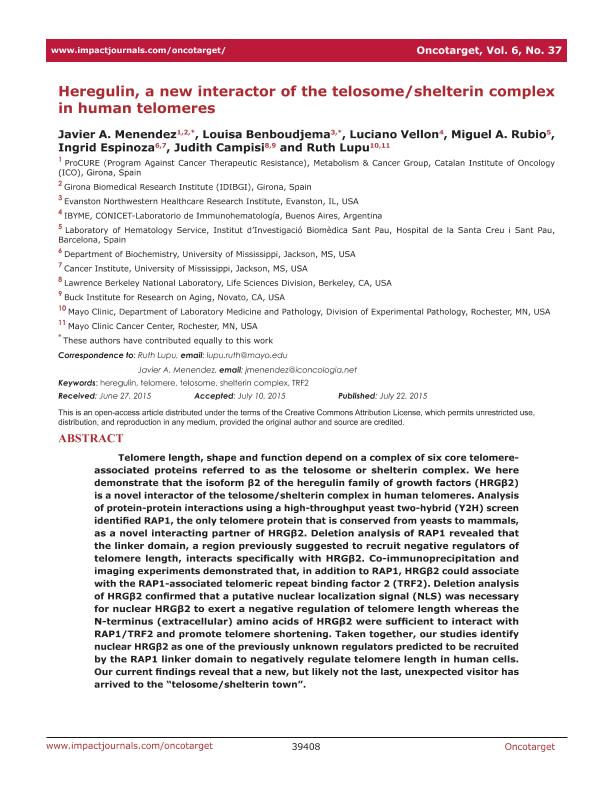Mostrar el registro sencillo del ítem
dc.contributor.author
Menendez, Javier A.
dc.contributor.author
Benboudjema, Louisa
dc.contributor.author
Vellón, Luciano

dc.contributor.author
Rubio, Miguel A.
dc.contributor.author
Espinoza, Ingrid
dc.contributor.author
Campisi, Judith
dc.contributor.author
Lupu, Ruth
dc.date.available
2016-10-19T18:28:57Z
dc.date.issued
2015-07-22
dc.identifier.citation
Menendez, Javier A.; Benboudjema, Louisa; Vellón, Luciano; Rubio, Miguel A.; Espinoza, Ingrid; et al.; Heregulin, a new interactor of the telosome/shelterin complex in human telomeres; Impact Journals; Oncotarget; 6; 37; 22-7-2015; 39408-39421
dc.identifier.issn
1949-2553
dc.identifier.uri
http://hdl.handle.net/11336/7739
dc.description.abstract
Telomere length, shape and function depend on a complex of six core telomere-associated proteins referred to as the telosome or shelterin complex. We here demonstrate that the isoform beta2 of the heregulin family of growth factors (HRGbeta2) is a novel interactor of the telosome/shelterin complex in human telomeres. Analysis of protein-protein interactions using a high-throughput yeast two-hybrid (Y2H) screen identified RAP1, the only telomere protein that is conserved from yeasts to mammals, as a novel interacting partner of HRGbeta2. Deletion analysis of RAP1 revealed that the linker domain, a region previously suggested to recruit negative regulators of telomere length, interacts specifically with HRGbeta2. Co-immunoprecipitation and imaging experiments demonstrated that, in addition to RAP1, HRGβ2 could associate with the RAP1-associated telomeric repeat binding factor 2 (TRF2). Deletion analysis of HRGβ2 confirmed that a putative nuclear localization signal (NLS) was necessary for nuclear HRGbeta2 to exert a negative regulation of telomere length whereas the N-terminus (extracellular) amino acids of HRGbeta2 were sufficient to interact with RAP1/TRF2 and promote telomere shortening. Taken together, our studies identify nuclear HRGbeta2 as one of the previously unknown regulators predicted to be recruited by the RAP1 linker domain to negatively regulate telomere length in human cells. Our current findings reveal that a new, but likely not the last, unexpected visitor has arrived to the "telosome/shelterin town".
dc.format
application/pdf
dc.language.iso
eng
dc.publisher
Impact Journals
dc.rights
info:eu-repo/semantics/openAccess
dc.rights.uri
https://creativecommons.org/licenses/by/2.5/ar/
dc.subject
Trf2
dc.subject
Heregulin
dc.subject
Sheltering Complex
dc.subject
Telomere
dc.subject
Telosome
dc.subject.classification
Bioquímica y Biología Molecular

dc.subject.classification
Ciencias Biológicas

dc.subject.classification
CIENCIAS NATURALES Y EXACTAS

dc.title
Heregulin, a new interactor of the telosome/shelterin complex in human telomeres
dc.type
info:eu-repo/semantics/article
dc.type
info:ar-repo/semantics/artículo
dc.type
info:eu-repo/semantics/publishedVersion
dc.date.updated
2016-10-04T19:27:15Z
dc.identifier.eissn
1949-2553
dc.journal.volume
6
dc.journal.number
37
dc.journal.pagination
39408-39421
dc.journal.pais
Estados Unidos

dc.journal.ciudad
Nueva York
dc.description.fil
Fil: Menendez, Javier A.. Catalan Institute of Oncology; España. Girona Biomedical Research Institute; España
dc.description.fil
Fil: Benboudjema, Louisa. Evanston Northwestern Healthcare Research Institute; Estados Unidos
dc.description.fil
Fil: Vellón, Luciano. Consejo Nacional de Investigaciones Científicas y Técnicas. Instituto de Biología y Medicina Experimental (i); Argentina
dc.description.fil
Fil: Rubio, Miguel A.. Hospital de la Santa Creu i Sant Pau. Institut d’Investigació Biomèdica Sant Pau,; España
dc.description.fil
Fil: Espinoza, Ingrid. University Of Mississippi; Estados Unidos. Lawrence Berkeley National Laboratory; Estados Unidos
dc.description.fil
Fil: Campisi, Judith. Lawrence Berkeley National Laboratory; Estados Unidos. Buck Institute for Research on Aging; Estados Unidos
dc.description.fil
Fil: Lupu, Ruth. Mayo Clinic Cancer Center; Estados Unidos. Mayo Clinic. Department of Laboratory Medicine and Pathology; Estados Unidos
dc.journal.title
Oncotarget
dc.relation.alternativeid
info:eu-repo/semantics/altIdentifier/url/https://www.ncbi.nlm.nih.gov/pmc/articles/PMC4741835/
dc.relation.alternativeid
info:eu-repo/semantics/altIdentifier/doi/http://dx.doi.org/10.18632/oncotarget.4962
dc.relation.alternativeid
info:eu-repo/semantics/altIdentifier/url/http://www.impactjournals.com/oncotarget/index.php?journal=oncotarget&page=article&op=view&path[]=4962&pubmed-linkout=1
Archivos asociados
